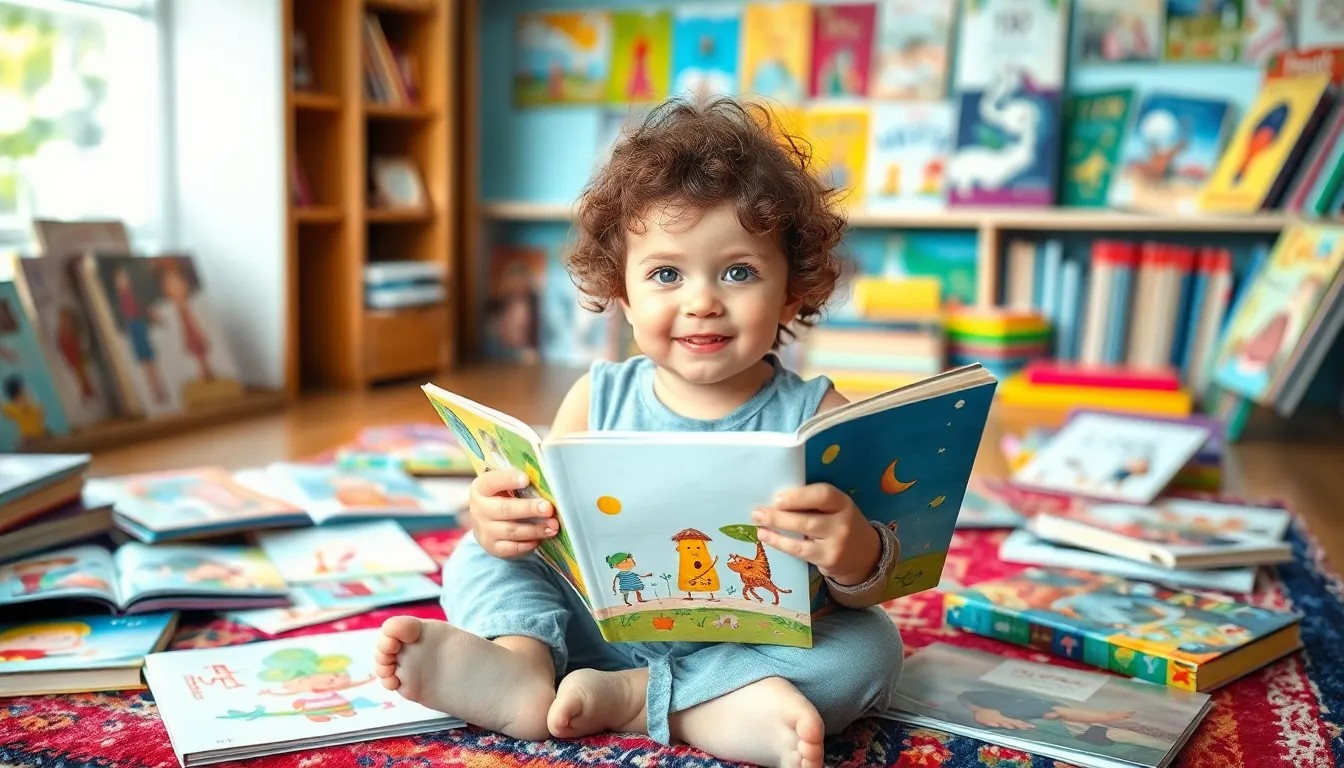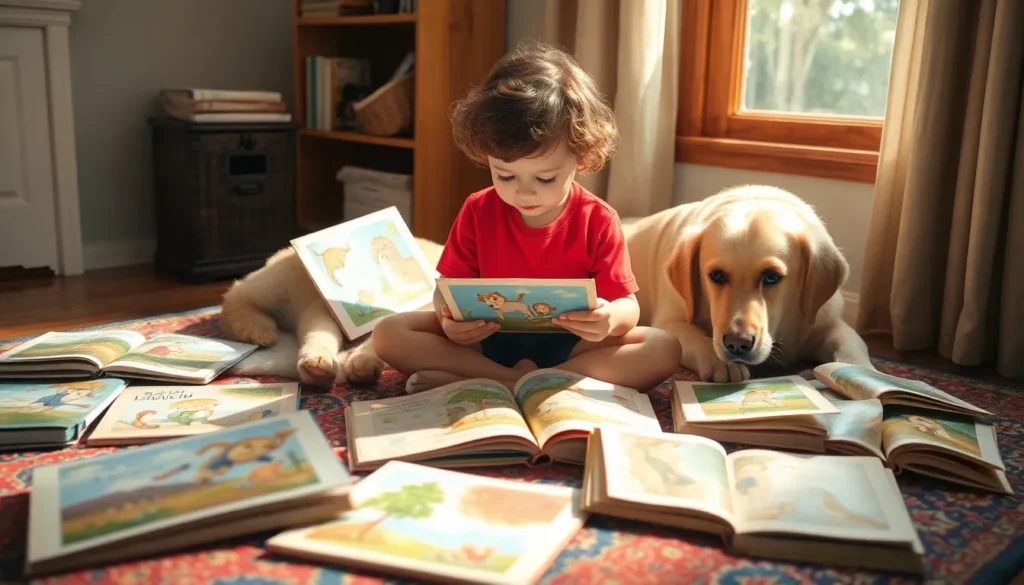Table of Contents
TogglePicture books are more than just colorful pages; they’re gateways to imagination and adventure. With each turn of the page, kids dive into worlds filled with quirky characters and whimsical tales that spark creativity. Who wouldn’t want to join a dancing dinosaur or a flying pig on their next escapade?
These delightful stories do more than entertain; they lay the groundwork for literacy and critical thinking. Picture books invite children to explore language, rhythm, and art, all while giggling at the antics of a mischievous cat. So grab a cozy blanket and a cup of cocoa—it’s time to discover why picture books are the ultimate charmers in the literary world, capturing hearts and minds one story at a time.
Overview of Picture Books
Picture books blend illustrations and text, creating inviting experiences for young readers. These books typically target children aged 0 to 8 years, though they appeal to readers of all ages. Illustrations captivate the imagination, making complex concepts accessible. Vibrant images complement engaging narratives, creating stories that resonate.
Many picture books focus on essential themes such as friendship, adventure, and courage. Repeated exposure to these themes enhances children’s understanding of emotions and social interactions. Furthermore, the interaction between text and illustrations encourages critical thinking. Readers analyze details within images while decoding the story.
Research from the National Association for the Education of Young Children highlights the role of picture books in language development. Vocabulary acquisition increases with shared reading sessions. Children exposed to rich language and diverse themes develop better verbal skills and comprehension.
Picture books can take various forms, including wordless stories and concept books. Wordless picture books encourage creativity by allowing children to create their narratives. Concept books often focus on simple ideas like numbers or colors, laying the foundation for early literacy.
Additionally, publishers continue to release new titles, reflecting diverse cultures and experiences. This inclusivity fosters empathy and understanding among children. As they explore different perspectives, they build social awareness and appreciation for diversity.
Understanding the impact of picture books helps caregivers and educators prioritize reading time. Embracing the charm of these books opens avenues for learning and growth, making reading a delightful experience.
Importance of Picture Books

Picture books offer significant benefits for children beyond entertainment. They play a vital role in early childhood development.
Cognitive Development
Cognitive development is enhanced through picture books. Engaging narratives paired with illustrations help children grasp complex ideas. Readers learn to make connections between images and words, fostering comprehension skills. Picture books encourage exploration of language patterns and vocabulary. Evidence indicates that interactive reading sessions improve vocabulary acquisition rates, as shown by the National Association for the Education of Young Children. Various formats, such as concept books, introduce foundational literacy skills. Learning becomes enjoyable through colorful characters and quirky plots, reinforcing critical thinking and problem-solving abilities.
Emotional Growth
Emotional growth flourishes with the help of picture books. Stories that depict diverse experiences promote empathy in young readers. Characters facing challenges teach important life lessons about resilience, friendship, and courage. Through relatable scenarios, children learn to navigate their own feelings and understand others’. Picture books often provide comfort, as they allow kids to confront fears in a safe environment. Connecting with characters fosters a sense of belonging and enhances self-awareness. Themes of kindness and acceptance resonate, contributing to social-emotional development as children engage with their peers and communities.
Elements of Picture Books
Picture books combine illustrations and text to create engaging experiences for young readers. Each element plays a vital role in attracting and sustaining children’s attention.
Illustrations
Illustrations serve as the heart of picture books, captivating young readers with vivid imagery. Bright colors and dynamic scenes invite exploration and imagination. Artists often use a variety of techniques, like watercolor or collage, to evoke emotions and enhance the narrative. Readers interpret visual details, allowing for personal connections to the story. Illustrations often depict characters, settings, and actions that reinforce the themes present in the text. Incorporating diverse styles fosters appreciation for various artistic expressions, promoting inclusivity.
Text
Text complements illustrations, conveying the story and enriching the reading experience. Short sentences and rhythmic language provide accessibility for early readers. Authors often choose simple vocabulary to engage children while introducing new words, aiding vocabulary development. A consistent narrative structure fosters understanding and retention of the story. Word choice impacts the pacing and emotional tone, enhancing the connection between characters and readers. Text in picture books often plays a role in prompting discussion and critical thinking, encouraging readers to explore their own interpretations of the story.
Genres of Picture Books
Picture books encompass a variety of genres that engage young readers through imaginative narratives and informative content. Understanding these genres helps in selecting the right book for every child.
Fiction
Fiction picture books transport readers into vibrant worlds filled with whimsical characters and adventurous plots. Stories often center on themes like friendship, courage, and curiosity, enabling children to explore emotions and moral lessons. Notable examples include classics such as “Where the Wild Things Are” and newer favorites like “The Gruffalo.” These narratives captivate attention through rhythmic language and playful storytelling that encourages imagination. Illustrations enhance the experience by visualizing the story, allowing readers to grasp complex concepts in a relatable manner. By immersing children in fictional tales, these books stimulate creative thinking and communication skills.
Non-Fiction
Non-fiction picture books provide factual information in an engaging format, fostering curiosity about the world. Topics range from science and history to culture and nature, appealing to a child’s inquisitive nature. Titles like “The Earth Book” and “Ada Twist, Scientist” introduce educational concepts while maintaining an entertaining narrative style. These books often use both illustrations and photographs to illustrate facts, making information accessible and appealing to young learners. A combination of clear language and well-organized content aids comprehension, promoting a deeper understanding of diverse subjects. Through non-fiction, children expand their knowledge and develop critical thinking skills, preparing them for lifelong learning.
Recommendations for Picture Books
Selecting the right picture books can enhance a child’s reading experience. “Where the Wild Things Are” by Maurice Sendak captivates young imaginations with its whimsical characters and adventure-filled narrative. “The Gruffalo” by Julia Donaldson offers an engaging story about bravery and cleverness, appealing to both kids and adults alike.
For non-fiction enthusiasts, “Ada Twist, Scientist” by Andrea Beaty introduces readers to scientific inquiry through a charming story. “The Earth Book” by Todd Parr presents environmental themes using colorful illustrations, making learning about nature enjoyable. Both titles foster curiosity and critical thinking skills among young readers.
Incorporating story times with diverse titles broadens children’s perspectives. “Last Stop on Market Street” by Matt de la Peña provides a look into different communities while teaching valuable life lessons. “All Are Welcome” by Alexandra Penfold encourages inclusivity, showcasing the beauty of diverse cultures in a school setting.
Additionally, wordless titles like “Flora and the Flamingo” by Molly Idle promote creativity. These books allow kids to create their own narratives and interpret the visuals independently. This process builds imagination and storytelling skills.
Engaging narratives paired with vibrant illustrations inspire emotional understanding. “The Family Book” by Todd Parr discusses the variety of family structures, promoting acceptance and empathy. Titles like “The Very Hungry Caterpillar” by Eric Carle introduce various concepts such as counting and days of the week, reinforcing early literacy fundamentals.
Combining enjoyment with education, these recommended picture books offer enriching experiences for readers of all ages. Parents and educators can leverage these titles to stimulate discussions and promote a love for reading.
Picture books are essential tools in a child’s development journey. They not only entertain but also educate and inspire. Through vibrant illustrations and engaging narratives, these books foster creativity and critical thinking skills.
As children explore diverse stories and characters, they gain insights into friendship, resilience, and empathy. The impact of picture books extends beyond literacy; they nurture emotional growth and social awareness.
Encouraging shared reading experiences can significantly enhance vocabulary and comprehension. By embracing the magic of picture books, parents and educators can cultivate a lifelong love for reading in children, setting the stage for future learning adventures.







